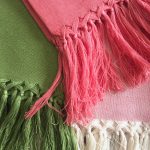Italian Thoughts
We traveled to Italy this past month, having so much fun assisting Victoria Magazine with their work for an upcoming issue dedicated to Tuscany (summer 2023) which will feature Busatti as a centerpiece.
Our group included Melissa, Senior Director of Design and Stephanie, Editorial Photographer and my driver and translator and all-around helper and husband, Paul.
Our group time together began at Il Falconiere, the Baracchi family 17th century villa and land in the countryside of Cortona that has been transformed into a 5 star resort and Michelin restaurant, surrounded by vineyards and olive groves. Warmth and elegance define Il Falconiere, enhanced by Busatti fabrics being used in furnishing all guest and dining rooms. Our very hard work there included enjoying spectacular meals in the soaring dining room and apertivo in the intimate bar; tasting all the wines that the Baracchi label produces; swimming in the warm spa pool; walking gravel pathways leading us through charming structures, gardens, and the champagniere; partaking in the cooking school luncheon; and falling asleep under quiet stars and countryside sounds. We drove a short way to dine at Locanda del Molino, a exemplary Tuscan trattoria and Silvia Baracchi’s family home and inn where she first learned to cook her way towards a Michelin star. We left the countryside to spend the day in Cortona, looking at sacred spaces and art (@museodiocesanocortona our first stop), shopping (@rugapiana_cortona_montepulciano and @terraruga_ceramiche_), and visiting @bottegabaracchi , a shop for Busatti and other Tuscan treasures, a ristorante and enoteca.
We were so inspired by all at Il Falconiere – a place that immediately impresses then remains with you in memory and grows; and we so enjoyed the gracious companionship and hospitality of its owner Silvia and manager Anna Maria.
We drove away after our rich days in Cortona to our next destination of Anghiari and Busatti. The weaving factory and shop in the Palazzo Morgalanti; our friends at Busatti who we email/WhatsApp daily, yet see too rarely; the historical family spaces; the views down the Roman road and across the valleys towards Sansepolcro; the churches with bells ringing every hour (and marking half hour); morning caffè at Caffe dello Sport; the weekly market with freshly harvested chestnuts to carry home; the entirety of the town (with outstanding restaurants) – we’d love to repeat every moment, despite the rain that was our partner most days! Everyone at Busatti is so generous with their time, their attention, their affection, their welcome; we are lucky and grateful.
I spent time at Busatti reviewing customer and shops orders; looking at larger pieces of fabrics, color ways, and finishes in person; combing the shelves for some vintage finished pieces to bring to our Shop; and gathering new ideas all around. We dined each meal with varying groups, including our Atlanta friends, Steve and Cathy, who now live there; peek into their Tuscan life @sprezzaturayall .
Paul and i returned to Monterchi on our last day, to again see Piero della Francesca’s Madonna del Parto, and to also see the chapel that originally housed the work (now a part of a cimitero) and walk through the town on Monterchi (very quiet, in the misting rain). We had a parting group aperitivo and dinner in Città di Castello, which Paul and I raced to in pouring rain after visiting the renaissance palace housing the Pinacoteca Città Castello – with a spectacular patterned facade designed by Vasari, formal courtyard gardens, and winding rooms filled with frescoes and sacred paintings and art.
We waved goodbye to Anghiari after our morning caffè, as practice and preparations were underway for L’Intrepida, the annual mid-October vintage biking event (no bikes newer than 1987) on the steep roads used during the battle that took place on the 29th of June, 1440, immortalized in Leonardo da Vinci’s lost painting: The Battle of Anghiari. The long arc of time is always present and brought alive in Italy. Melissa, Stephanie, Paul and I headed into Arezzo to attend the monthly Fiera Antiquaria, an antiques fair that sprawls on every street of the lovely town of of Arezzo. Paul and I had briefly visited the Fiera twice before, but never had the chance to wander with intent and leisure. The selection of items is incredibly varied, spanning centuries and categories; among a few other things, I found an antique marble plum for my fruits collection – painted perfect faded tones of mauve and gold . We ate a late lunch together, our last in Tuscany so ordered accordingly, before saying arriverdverci to our Victoria friends, for now! We will see them again soon in Atlanta and hope to visit their offices in Birmingham ahead.
Paul and I had a short time on both ends of the too-fun-and-pleasurable-to-be-called-work trip, and we used our time on each end so wisely. On the front end, after flying into Fiumicino, we drove up the coast before heading inland through Estrucan olive groves, past Lake Bolsena, continually spying the pathways of the Via Francigena (goal), towards the elegant spa town of Bagno Vignoni in the most beautiful region of Val d’Orcia. Our stay was magic, swimming in and out of cover in thermal pools in the cool pelting rain, eating one of the best meals of our trip at L’Osteria del Porcellum (all the evening’s specials: meringue semi-freddo to end after a meal of figs, local cheese, prosciutto, osso buco, and pappardelle with funghi -the latter ingredient eaten at almost every meal, as it was that time of year), climbing the Rocca d’Orcia and dining at its base (funghi again, piled on bread, with melted local cheese and herbs). We drove past Pienza, a place we would visit over and over if we had time, through San Quirico, which we had not previously seen but will return to, and as we drove towards our destination of Cortona, we glimpsed from afar then found our way to the foot path leading us to the diminutive 19th century Vitaleta Chapel (Cappella della Madonna Vitaleta), situated in a wide open area of rolling hills and fields. Its simple facade of white Rapolano stone and sides and apse of Pienza stone provided a beautiful sense of place. The chapel’s interior is under renovation, but the exterior was absolutely fulfilling to see.
On the other end of our trip, we left Arezzo to drive to Termini Station Roma to turn in our Fiat, and happily returned to our familiar hotel near the Pantheon. Paul lived in Rome for a year while I was in London for part of that time, so I visited him a number of times – this was when English was not widely spoken there and all things were quieter and easily accessible (as in, no lines, ever, for anything). We did a nostalgia tour, visiting his old architecture studio, old hotel, the campo, the forno, the walk to the Vatican, mass at Sant’Ivo, gelato (adding a new, excellent place on our back way walk to the Vatican), and meals in the Piazza Sant’Ignazio. We took the long walk from the Pantheon to Esquilino to meet Paul’s cousins Anna and Gaetano at the oldest gelateria in Rome, Fassi.
There is a reason to love Italy and this is it: it is a place where living is so close to the heart. It rejoices in what is present, honors what is timeless, and makes space for the pleasure of people together. What also always strikes me, as we visit family and friends’ homes there, is how particular to the person the space is, how layers are added over the years but the foundational choices remain, how rich the building materials and finishes are but how modest and true the impression is. These qualities are what draws me to using fabrics from Busatti – things made with skill, reflecting its natural environment, capturing beauty, and woven and finished for use in a life that holds fullness.
Salve, from back in America,
Sheila





